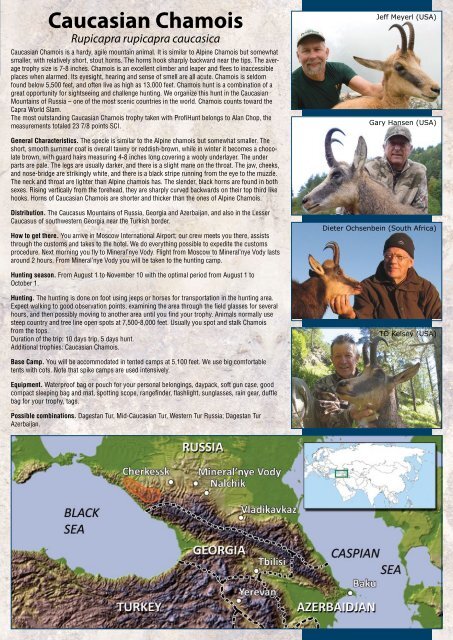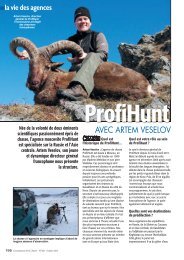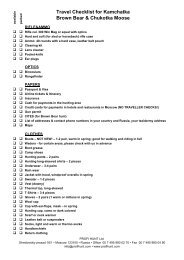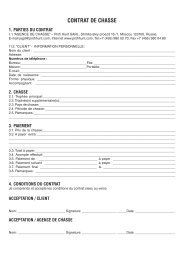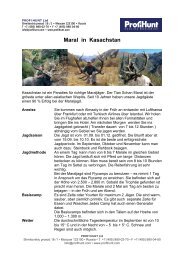Create successful ePaper yourself
Turn your PDF publications into a flip-book with our unique Google optimized e-Paper software.
Caucasian Chamois<br />
Rupicapra rupicapra caucasica<br />
Caucasian Chamois is a hardy, agile mountain animal. It is similar to Alpine Chamois but somewhat<br />
smaller, with relatively short, stout horns. The horns hook sharply backward near the tips. The average<br />
trophy size is 7-8 inches. Chamois is an excellent climber and leaper and flees to inaccessible<br />
places when alarmed. Its eyesight, hearing and sense of smell are all acute. Chamois is seldom<br />
found below 5,500 feet, and often live as high as 13,000 feet. Chamois hunt is a combination of a<br />
great opportunity for sightseeing and challenge hunting. We organize this hunt in the Caucasian<br />
Mountains of Russia – one of the most scenic countries in the world. Chamois counts toward the<br />
Capra World Slam.<br />
The most outstanding Caucasian Chamois trophy taken with ProfiHunt belongs to Alan Chop, the<br />
measurements totaled 23 7/8 points SCI.<br />
General Characteristics. The specie is similar to the Alpine chamois but somewhat smaller. The<br />
short, smooth summer coat is overall tawny or reddish-brown, while in winter it becomes a chocolate<br />
brown, with guard hairs measuring 4-8 inches long covering a wooly underlayer. The under<br />
parts are pale. The legs are usually darker, and there is a slight mane on the throat. The jaw, cheeks,<br />
and nose-bridge are strikingly white, and there is a black stripe running from the eye to the muzzle.<br />
The neck and throat are lighter than Alpine chamois has. The slender, black horns are found in both<br />
sexes. Rising vertically from the forehead, they are sharply curved backwards on their top third like<br />
hooks. Horns of Caucasian Chamois are shorter and thicker than the ones of Alpine Chamois.<br />
Distribution. The Caucasus Mountains of Russia, Georgia and Azerbaijan, and also in the Lesser<br />
Caucasus of southwestern Georgia near the Turkish border.<br />
How to get there. You arrive in Moscow International Airport; our crew meets you there, assists<br />
through the customs and takes to the hotel. We do everything possible to expedite the customs<br />
procedure. Next morning you fly to Mineral’nye Vody. Flight from Moscow to Mineral’nye Vody lasts<br />
around 2 hours. From Mineral’nye Vody you will be taken to the hunting camp.<br />
Hunting season. From August 1 to November 10 with the optimal period from August 1 to<br />
October 1.<br />
Hunting. The hunting is done on foot using jeeps or horses for transportation in the hunting area.<br />
Expect walking to good observation points, examining the area through the field glasses for several<br />
hours, and then possibly moving to another area until you find your trophy. Animals normally use<br />
steep country and tree line open spots at 7,500-8,000 feet. Usually you spot and stalk Chamois<br />
from the tops.<br />
Duration of the trip: 10 days trip, 5 days hunt.<br />
Additional trophies: Caucasian Chamois.<br />
Base Camp. You will be accommodated in tented camps at 5,100 feet. We use big comfortable<br />
tents with cots. Note that spike camps are used intensively.<br />
Equipment. Waterproof bag or pouch for your personal belongings, daypack, soft gun case, good<br />
compact sleeping bag and mat, spotting scope, rangefinder, flashlight, sunglasses, rain gear, duffle<br />
bag for your trophy, tags.<br />
Possible combinations. Dagestan Tur, Mid-Caucasian Tur, Western Tur Russia; Dagestan Tur<br />
Azerbaijan.<br />
Jeff Meyerl (USA)<br />
Gary Hansen (USA)<br />
Dieter Ochsenbein (South Africa)<br />
TD Kelsey (USA)


